Research on Double-Layer Optimized Configuration of Multi-Energy Storage in Regional Integrated Energy System with Connected Distributed Wind Power
Abstract
:1. Introduction
2. Framework of Regional Integrated Energy System
3. Double-Layer Optimized Model for Multi-Energy Storage
3.1. Upper Layer Planning Model Considering the Comprehensive Investment Cost of Multi-Storage
3.1.1. Objective Function of Upper Layer Model
3.1.2. Constraints of Upper Layer Model
3.2. Lower Layer Scheduling Model of Regional Integrated Energy System
3.2.1. Objective Function of Lower Layer Model
3.2.2. Lower Layer Model Constraints
4. Model Linearization
4.1. Linearization of Power Flow in Power System
4.2. Linearization of Pipeline Flow in Natural Gas System
5. Example Analysis
5.1. Composition of Example System
5.2. Result Comparison of Example Analysis
5.2.1. Result of Optimization When Wind Power Specific Permeability is 80%
5.2.2. Result of Optimization When Wind Power Specific Permeability is 30%
5.2.3. Economic Analysis without Heat Storage Device
6. Conclusions
- (1)
- The energy should be provided by the regional integrated power system to the distributed wind power when the wind power specific permeability is high in grid connection. When the natural gas price is lower than the real-time electricity price, it is not necessary to purchase electricity from the main network, while various load requirements can be met by natural gas turbine units and multi-energy storage devices.
- (2)
- During the time period when the real-time price is lower than the natural gas price in the regional integrated power system whose wind power specific permeability is low, the electricity should be purchased in a large volume from the main network and the electricity should be stored by the electricity storage device to release the energy in other time periods, thus to lower the operating costs.
- (3)
- The total operating cost in the regional integrated energy system will be lower when the multi-energy storage is taken into consideration, and extra investment costs can be recovered within one year, so it shares a higher economy.
Author Contributions
Funding
Acknowledgments
Conflicts of Interest
Nomenclature
| Indices | |
| t | Time (hours) |
| Time (days) | |
| n | Time (years) |
| i,j,k | branch line number |
| d | demand |
| Constants | |
| electricity storage capacity investment cost | |
| electricity storage capacity maintenance cost | |
| heat storage capacity investment cost | |
| heat storage capacity maintenance cost | |
| M | depreciation life of the energy storage |
| r | depreciation rate |
| minimum capacity value of electricity storage | |
| maximum capacity value of electricity storage | |
| minimum capacity value of heat storage | |
| maximum capacity value of heat storage | |
| minimum output value of distributed wind turbine | |
| maximum output value of distributed wind turbine | |
| maximum power of electricity storage | |
| maximum power of heat storage | |
| vr | rated wind speed |
| Pr | rated output power of distributed wind turbine |
| permeability value of distributed wind power | |
| electricity storage charge factors | |
| electricity storage discharge factors | |
| heat storage charge factors | |
| heat storage discharge factors | |
| electricity price | |
| natural gas price | |
| value of total nodes | |
| N | value of total nodes |
| net loss electricity price | |
| rij | resistance of branch ij |
| electricity demand | |
| heat demand | |
| gas demand | |
| minimum value of the branch current | |
| maximum value of the branch current | |
| Kij | natural gas pipeline parameter |
| minimum value of the pressure value | |
| maximum value of the pressure value | |
| conversion efficiency of gas boiler | |
| conversion efficiency of gas turbine | |
| waste heat recycling efficiency | |
| heating coefficient | |
| H | high thermal value of natural gas |
| Variables | |
| COC | the operating cost of upper layer |
| capacity value of electricity storage | |
| capacity value of heat storage | |
| output of distributed wind turbine | |
| vi | cut-in wind speed |
| vo | cut- out wind speed |
| charging binary marker variable | |
| discharging binary marker variable | |
| charging power of electricity storage | |
| charging power of electricity storage | |
| discharging power of heat storage | |
| charging power of heat storage | |
| heat power of gas boiler | |
| heat power of gas turbine | |
| current of line ij | |
| power purchase from the main grid | |
| output power of gas turbine | |
| natural gas consumption of gas turbine | |
| natural gas consumption of gas boiler | |
| natural gas supplied from natural gas sources | |
| natural gas pipeline flow of ij | |
| pipeline pressure | |
References
- Franz, F. The third Industrial Revolution. Int. Study Ref. 2012, 6, 8–11. [Google Scholar]
- Wang, D.; Liu, L.; Jia, H.; Wang, W.; Zhi, Y.; Meng, Z.; Zhou, B. Tianjin University Review of key problems related to integrated energy distribution systems. CSEE J. Power Energy Syst. 2018, 4, 130–145. [Google Scholar] [CrossRef]
- Tian, S.; Luan, W.; Zhang, D. Form and Key Technology of Energy Interconnection. Proc. Chin. Soc. Electr. Eng. 2015, 3, 3482–3494. [Google Scholar]
- Zakeri, B.; Syri, S. Electrical energy storage systems: A comparative life cycle cost analysis. Renew. Sustain. Energy Rev. 2015, 42, 569–596. [Google Scholar] [CrossRef]
- Larcher, D.; Tarascon, J. Towards greener and more sustainable batteries for electrical energy storage. Nat. Chem. 2015, 7, 19. [Google Scholar] [CrossRef] [PubMed]
- Jiang, Q.; Gong, Y.; Wang, H. A battery energy storage system dual-layer control strategy for mitigating windfarm fluctuations. IEEE Trans. Power Syst. 2013, 28, 3263–3273. [Google Scholar] [CrossRef]
- Yuan, Y.; Zhang, X.S.; Ju, P.; Li, Q.; Qian, K.; Fu, Z. Determination of economic dispatch of wind farm-battery energy storage system using genetic algorithm. Int. Trans. Electr. Energy Syst. 2014, 24, 264–280. [Google Scholar] [CrossRef]
- Li, J.; Tian, L.; Lai, X. Outlook of electrical energy storage technologies under energy internet background. Autom. Electr. Power Syst. 2015, 39, 15–25. [Google Scholar]
- Hartmann, B.; Dan, A. Cooperation of a grid-connected wind farm and an energy storage unit-demonstration of a simulation tool. IEEE Trans. Sustain. Energy 2012, 3, 49–56. [Google Scholar] [CrossRef]
- Yang, J.; Zhang, N.; Cheng, Y.; Kang, C.; Xia, Q. Modeling the Operation Mechanism of Combined P2G and Gas-fired Plant with CO2 Recycling. IEEE Trans. Smart Grid 2019, 10, 1111–1121. [Google Scholar] [CrossRef]
- Zhao, B.; Conejo, A.J.; Sioshansi, R. Unit Commitment Under Gas-Supply Uncertainty and Gas-Price Variability. IEEE Trans. Power Syst. 2017, 32, 2394–2405. [Google Scholar] [CrossRef]
- Zheng, J.H.; Wu, Q.H.; Jing, Z.X. Coordinated scheduling strategy to optimize conflicting benefits for daily operation of integrated electricity and gas networks. Appl. Energy 2016, 192, 370–381. [Google Scholar] [CrossRef]
- Mago, P.; Chamra, L. Analysis and optimization of CCHP systems based on energy, economical, and environmental considerations. Energy Build. 2009, 41, 1099–1106. [Google Scholar] [CrossRef]
- Li, J.; Tian, L.; Lai, X. Prospect of power storage technology under Energy Interconnection. Autom. Electr. Power Syst. 2015, 18, 15–25. [Google Scholar]
- Wang, C.; Liu, H.; Gong, J. Multi-type Energy Storage Joint Dispatch for Wind Power Elimination. Electr. Power Constr. 2018, 39, 35–44. [Google Scholar]
- Kwasinski, A.; Krishnamurthy, V.; Song, J.; Sharma, R. Availability Evaluation of Micro-Grids for Resistant Power Supply During Natural Disasters. IEEE Trans. Smart Grid 2012, 3, 2007–2018. [Google Scholar] [CrossRef]
- Wang, D.; Zhi, Y.; Yu, B.; Chen, Z.; An, Q.; Cheng, L.; Fan, M.; Tianjin University; China Electric Power Research Institute; State Grid Tianjin Electric Power Corporation. Optimal coordination control strategy of hybrid energy storage systems for tie-line smoothing services in integrated community energy systems. CSEE J. Power Energy Syst. 2018, 4, 408–416. [Google Scholar] [CrossRef]
- Shabanpour-Haghighi, A.; Seifi, A.R. Multi-objective operation management of a multi-carrier energy system. Energy 2015, 88, 430–442. [Google Scholar] [CrossRef]
- Beigvand, S.D.; Abdi, H.; La Scala, M. Optimal operation of multicarrier energy systems using Time Varying Acceleration Coefficient Gravitational Search Algorithm. Energy 2016, 114, 253–265. [Google Scholar] [CrossRef]
- Sedghi, M.; Ahmadian, A.; Aliakbar-Golkar, M. Optimal Storage Planning in Active Distribution Network Considering Uncertainty of Wind Power Distributed Generation. IEEE Trans. Power Syst. 2015, 31, 1–13. [Google Scholar] [CrossRef]
- Giannitrapani, A.; Paoletti, S.; Vicino, A.; Zarrilli, D. Optimal allocation of energy storage systems for voltage control in LV distribution networks. IEEE Trans. Smart Grid 2017, 8, 2859–2870. [Google Scholar] [CrossRef]
- Zhang, L.; Tang, W.; Cong, P. Comprehensive Optimized Allocation for Active and Reactive Power in Distributed Network with Photovoltaic Power Generation. Proc. Chin. Soc. Electr. Eng. 2014, 8, 5525–5533. [Google Scholar]
- Gao, H.; Liu, J. Collaborative Planning of Active Distributed Network that Considers Various Types of DG and Load Modelling. Proc. Chin. Soc. Electr. Eng. 2016, 36, 4911–4922. [Google Scholar]
- Dai, Y.; Chen, L.; Min, Y.; Mancarella, P.; Chen, Q.; Hao, J.; Hu, K.; Xu, F. A General Model for Thermal Energy Storage in Combined Heat and Power Dispatch Considering Heat Transfer Constraints. IEEE Trans. Sustain. Energy 2018, 9, 1518–1528. [Google Scholar] [CrossRef]
- Bansal, A.; Kumar, A.; Kumar, N. Optimization of radial distribution system losses with wind weibull distribution function integration using PSO and GA technique. In Proceedings of the 2016 7th India International Conference on Power Electronics (IICPE), Patiala, India, 17–19 November 2016. [Google Scholar]
- Lu, Z.; Sui, Y.; Feng, T. Wind Power Consumption with Low-carbon Economy Scheduling that Considers Heat Storage and Carbon-trapping Equipment. Trans. China Electrotech. Soc. 2016, 31, 1418–1428. [Google Scholar]
- Pandey, A.; Jereminov, M.; Wagner, M.R.; Bromberg, D.M.; Hug, G.; Pileggi, L. Robust Power Flow and Three Phase Power Flow Analyses. IEEE Trans. Power Syst. 2019, 34, 616–626. [Google Scholar] [CrossRef]
- He, Y.; Shahidehpour, M.; Li, Z.; Guo, C.; Zhu, B. Robust Constrained Operation of Integrated Electricity- Natural Gas System Considering Distributed Natural Gas Storage. IEEE Trans. Sustain. Energy 2018, 9, 1061–1071. [Google Scholar] [CrossRef]
- Salimi, M.; Adelpour, M.; Vaez-Zadeh, S.; Ghasemi, H. Optimal planning of energy hubs in interconnected energy systems: A case study for natural gas and electricity. IET Gener. Transm. Distrib. 2015, 9, 695–707. [Google Scholar] [CrossRef]
- Cui, Y.; Chen, Z.; Yan, G. Coordinated Wind Power Accommodating Dispatch Model Based on Electric Boiler and CHP with Thermal Energy Storage. Proc. Chin. Soc. Electr. Eng. 2016, 36, 4072–4080. [Google Scholar]
- Li, H.; Cui, H.; Wan, Q. Distribution Network Reconfiguration based on Second-order Conic Programming Considering EV Charging Strategy. Proc. Chin. Soc. Electr. Eng. 2015, 35, 4674–4681. [Google Scholar]
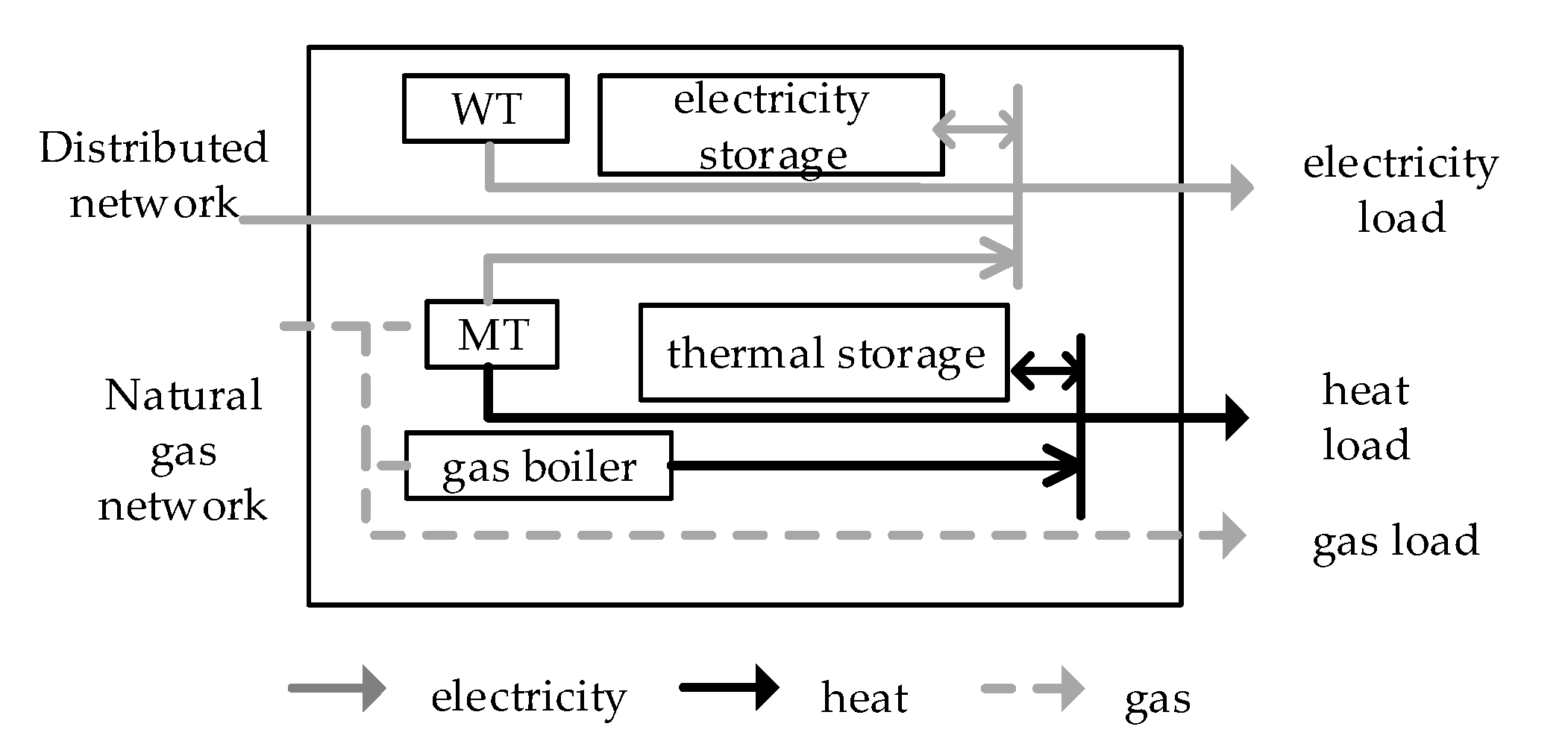
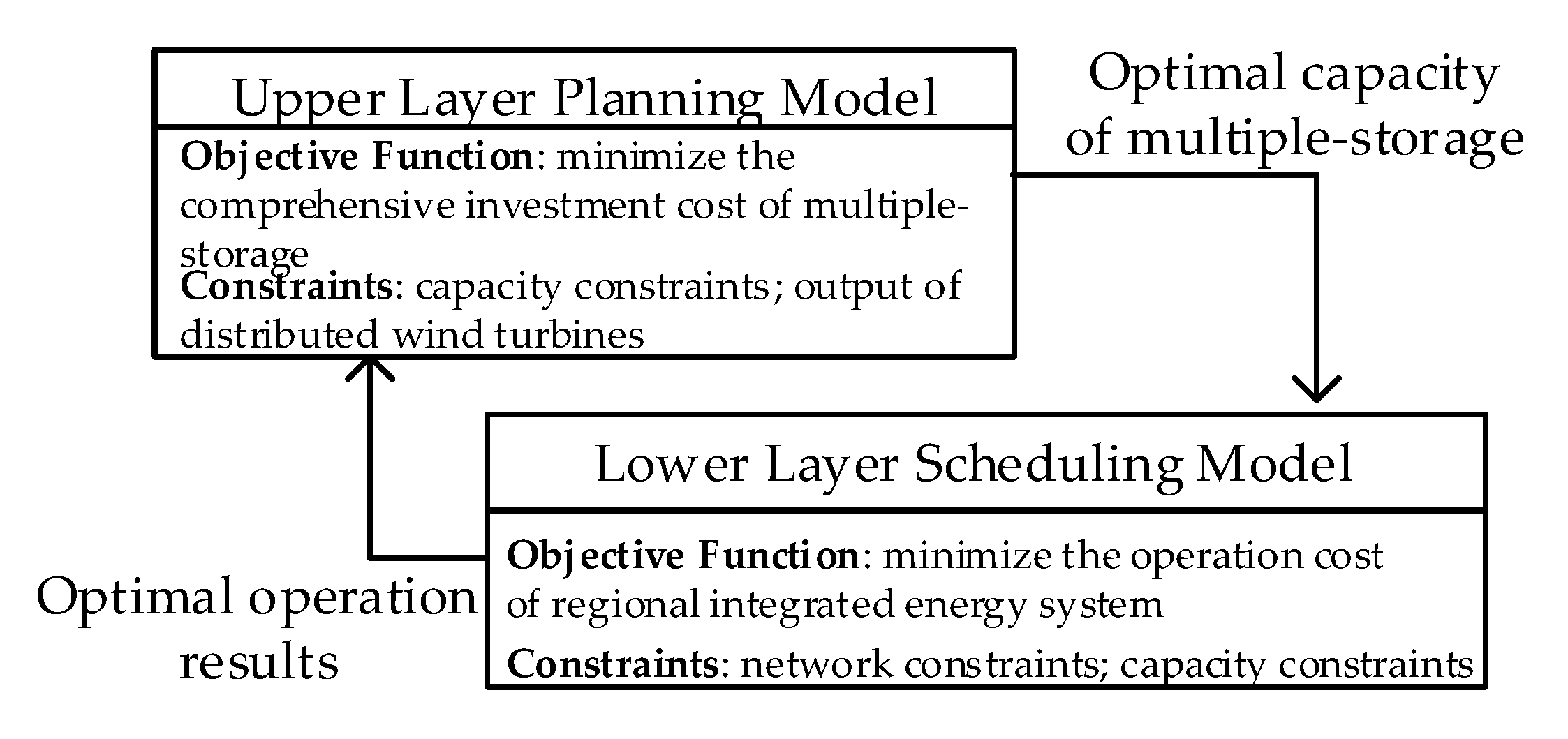

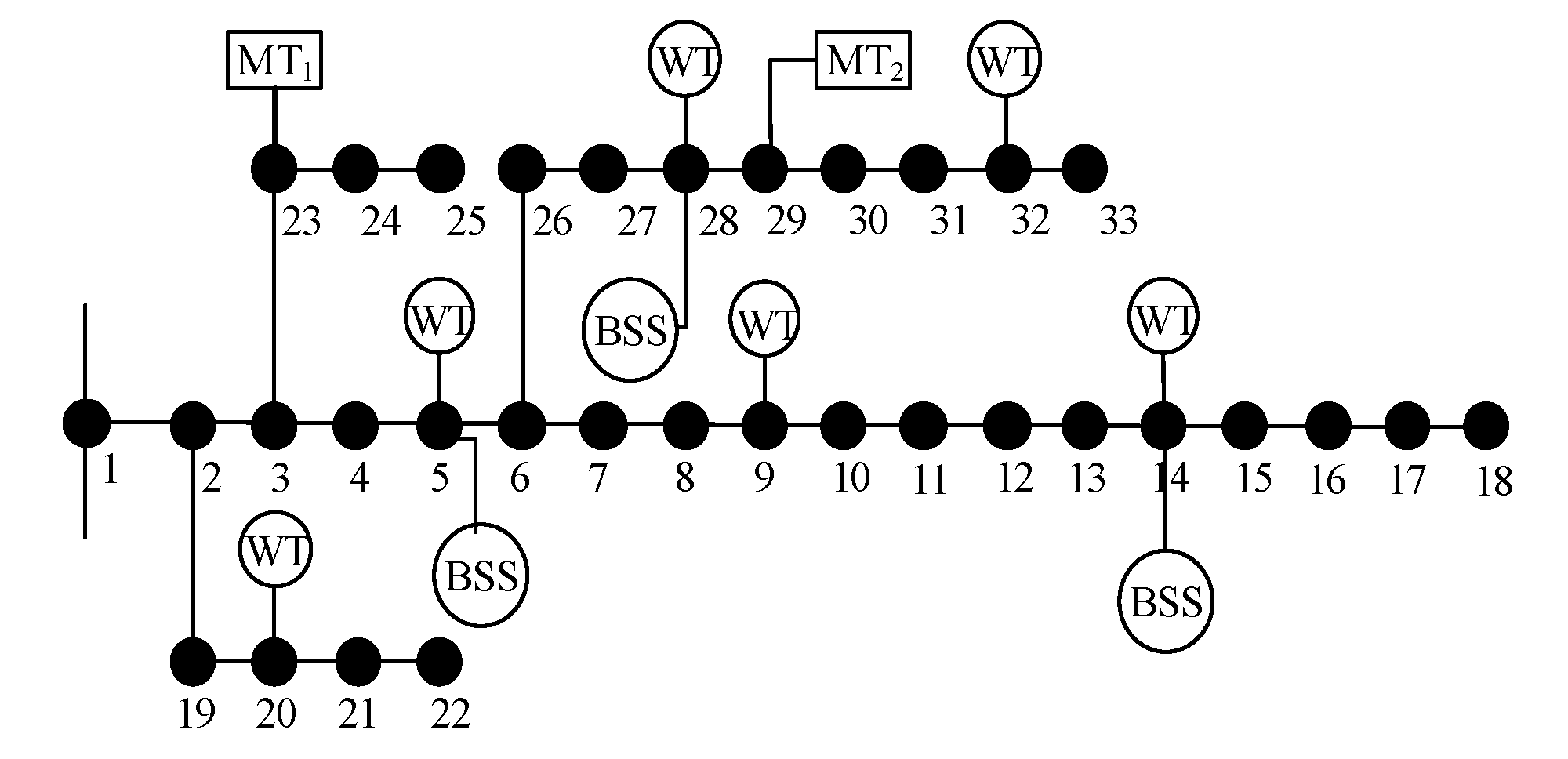
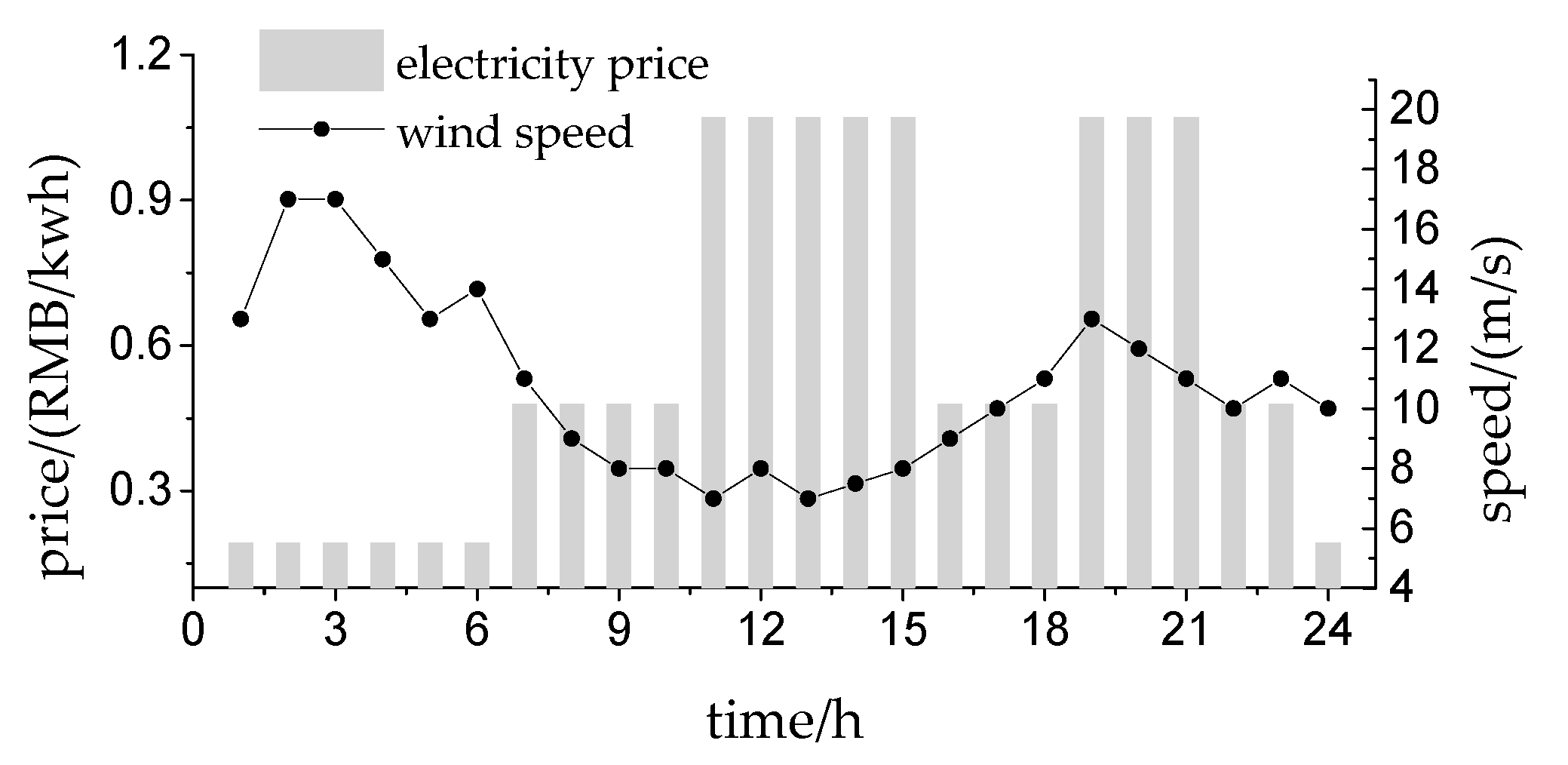
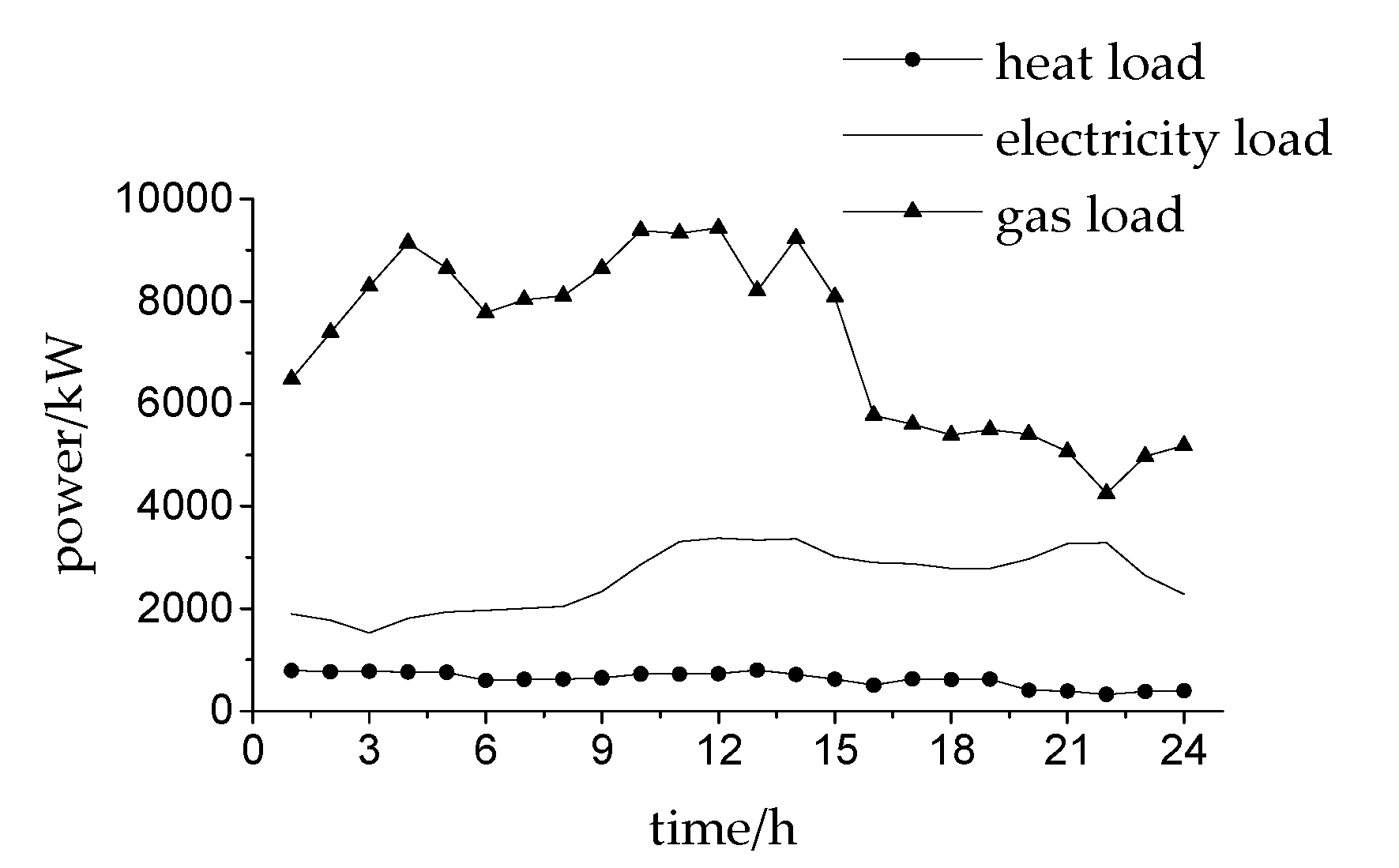
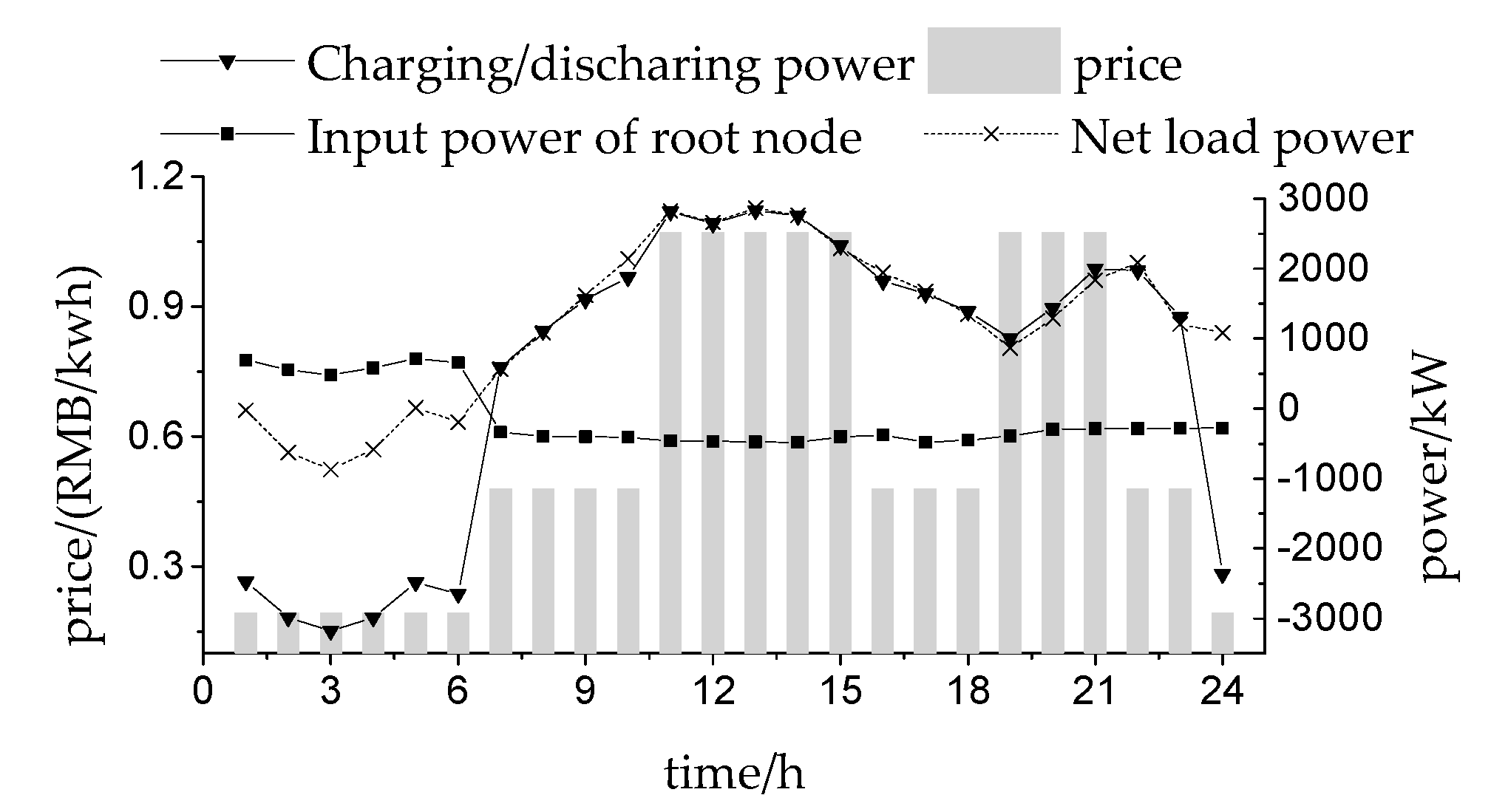
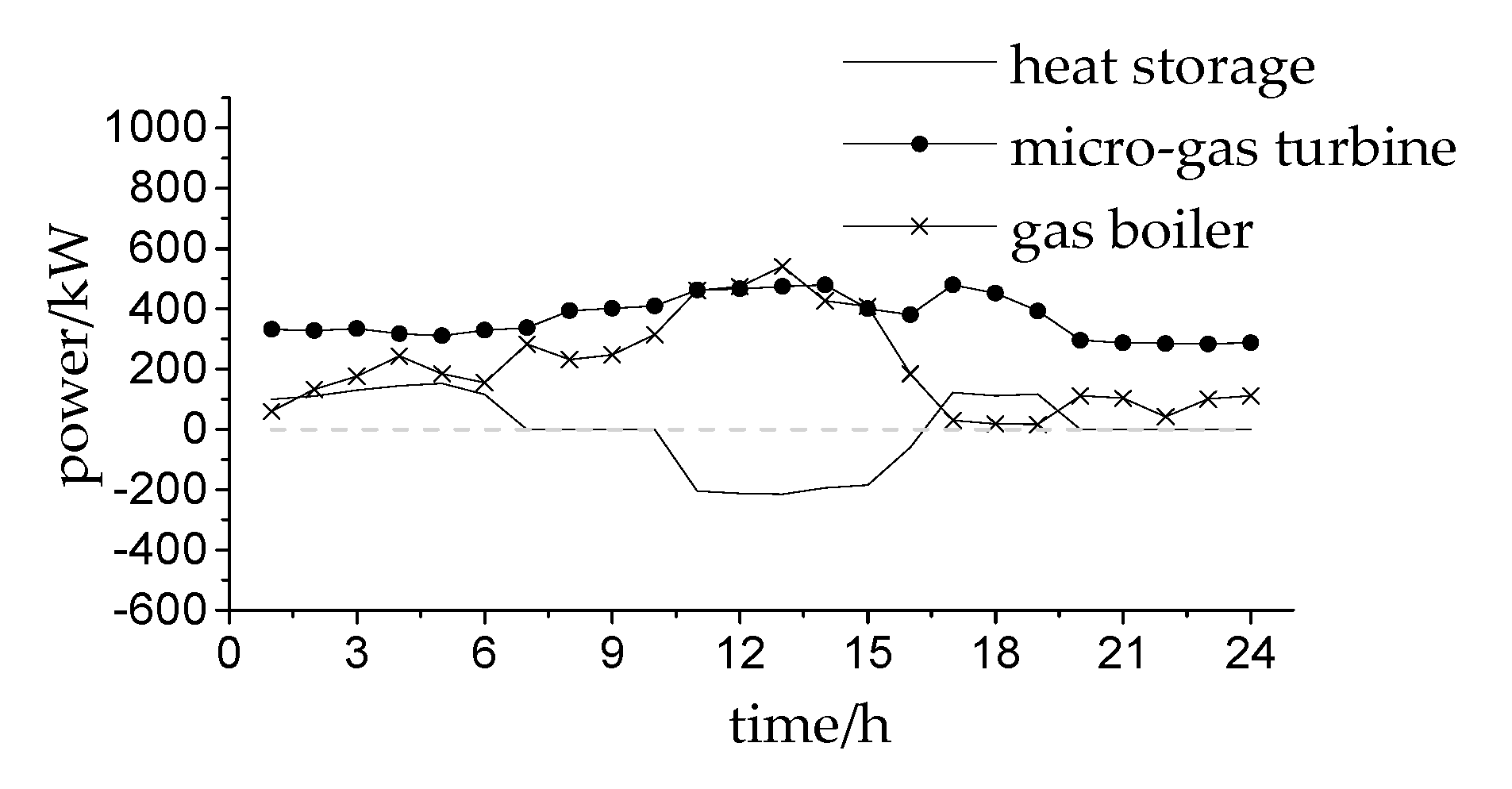

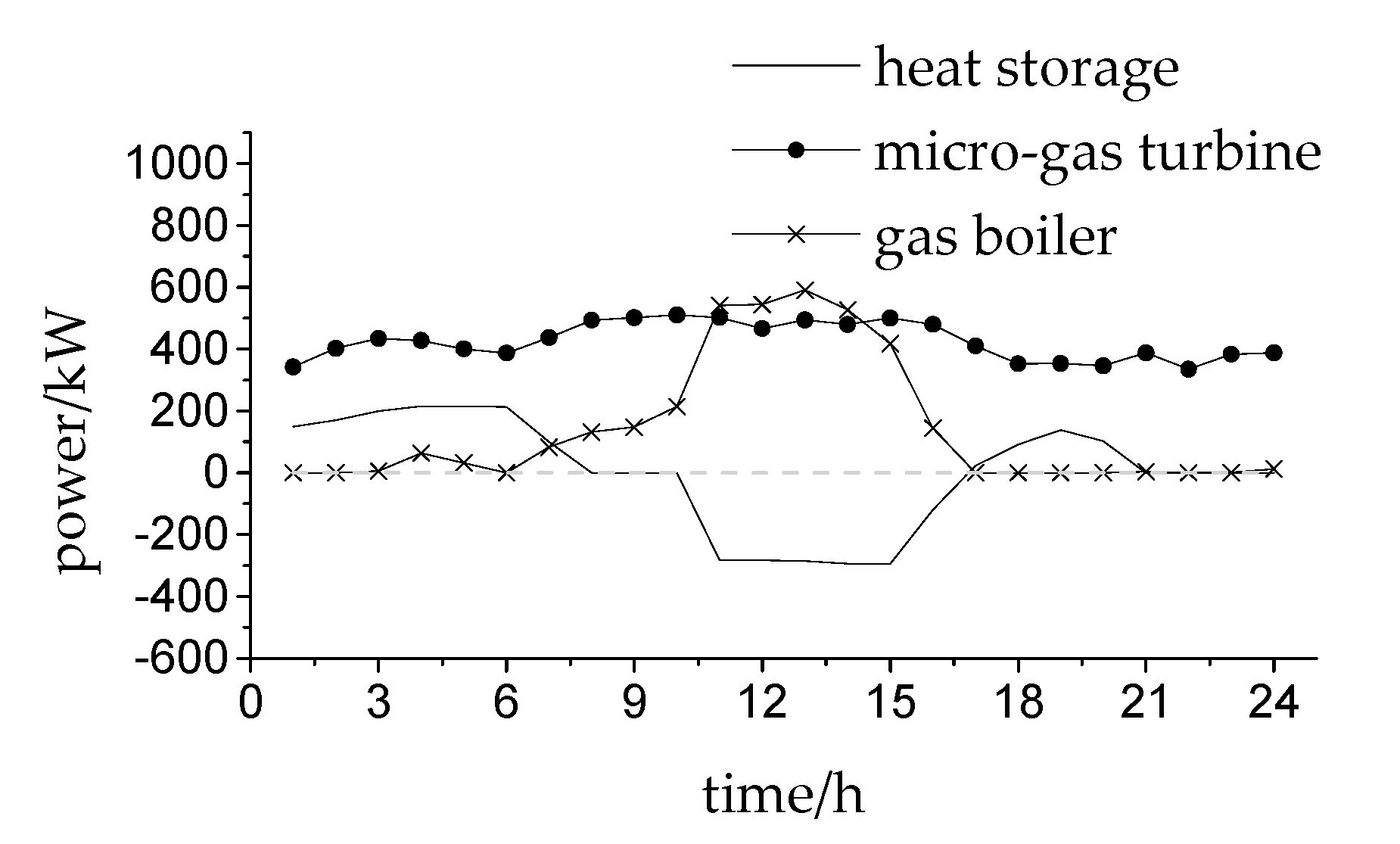
| Parameters | Electricity Storage | Thermal Storage |
|---|---|---|
| Nominal capacity/(W·h) | 1000 | 400 |
| Maximum charge and discharge power/W | 500 | 200 |
| Initial capacity/(W·h) | 500 | 200 |
| Investment cost/(yuan/W·h) | 1.521 | 1.39 |
| Operating and maintenance cost/(yuan/W·h) | 0.003 | 0.002 |
| Life cycle/year | 10 | 10 |
| Bank rate | 0.05 | 0.0475 |
| Category | Location | Storage Capacity/(MW·h) | Total Cost for Storage Investment/yuan | Electricity Purchase Cost from Main Network/yuan | Gas Purchase Cost | Net Loss Cost/yuan | Total Daily Operating Cost/yuan |
|---|---|---|---|---|---|---|---|
| Electricity storage | 5 | 26.877 | 15,274,000 | 4927.2 | 3874.3 | 798.35 | 15,117 |
| 16 | 5.419 | ||||||
| 27 | 9.552 | ||||||
| Heat storage | - | 36.313 | 5,061,200 | ||||
| - | 36.434 |
| Category | Location | Storage Capacity/(MW·h) | Total Cost for Storage Investment/yuan | Electricity Purchase Cost from Main Network/yuan | Gas Purchase Cost/yuan | Net Loss Cost/yuan | Total Daily Operating Cost/yuan |
|---|---|---|---|---|---|---|---|
| Electricity storage | 5 | 34.053 | 16,017,000 | 12,222 | 5191.8 | 1196 | 23,012 |
| 16 | 3.959 | ||||||
| 27 | 5.869 | ||||||
| Heat storage | - | 38.28 | 5,332,700 | ||||
| - | 38.37 |
| Without Heat Storage Devices (Unit:/yuan) | With Heat Storage Devices (Unit:/yuan) | ||
|---|---|---|---|
| Total investment cost | Daily operating cost | Total investment cost | Daily operating cost |
| 16,028,000 | 18,187 | 20,335,200 | 15,117 |
© 2019 by the authors. Licensee MDPI, Basel, Switzerland. This article is an open access article distributed under the terms and conditions of the Creative Commons Attribution (CC BY) license (http://creativecommons.org/licenses/by/4.0/).
Share and Cite
Zhang, Q.; Ren, Z.; Ma, R.; Tang, M.; He, Z. Research on Double-Layer Optimized Configuration of Multi-Energy Storage in Regional Integrated Energy System with Connected Distributed Wind Power. Energies 2019, 12, 3964. https://doi.org/10.3390/en12203964
Zhang Q, Ren Z, Ma R, Tang M, He Z. Research on Double-Layer Optimized Configuration of Multi-Energy Storage in Regional Integrated Energy System with Connected Distributed Wind Power. Energies. 2019; 12(20):3964. https://doi.org/10.3390/en12203964
Chicago/Turabian StyleZhang, Quanming, Zhichao Ren, Ruiguang Ma, Ming Tang, and Zhongxiao He. 2019. "Research on Double-Layer Optimized Configuration of Multi-Energy Storage in Regional Integrated Energy System with Connected Distributed Wind Power" Energies 12, no. 20: 3964. https://doi.org/10.3390/en12203964
APA StyleZhang, Q., Ren, Z., Ma, R., Tang, M., & He, Z. (2019). Research on Double-Layer Optimized Configuration of Multi-Energy Storage in Regional Integrated Energy System with Connected Distributed Wind Power. Energies, 12(20), 3964. https://doi.org/10.3390/en12203964




